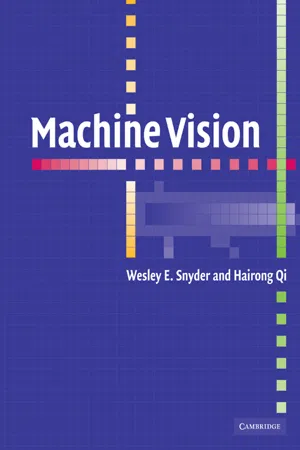Machine Vision
About this book
This 2004 book is an accessible and comprehensive introduction to machine vision. It provides all the necessary theoretical tools and shows how they are applied in actual image processing and machine vision systems. A key feature is the inclusion of many programming exercises that give insights into the development of practical image processing algorithms. The authors begin with a review of mathematical principles and go on to discuss key issues in image processing such as the description and characterization of images, edge detection, restoration and feature extraction, segmentation, texture and shape. They also discuss image matching, statistical pattern recognition, clustering, and syntactic pattern recognition. Important applications are described, including optical character recognition and automatic target recognition. Software and data used in the book can be found at www.cambridge.org/9780521830461. A useful reference for practitioners, the book is aimed at graduate students in electrical engineering, computer science and mathematics.
Frequently asked questions
- Essential is ideal for learners and professionals who enjoy exploring a wide range of subjects. Access the Essential Library with 800,000+ trusted titles and best-sellers across business, personal growth, and the humanities. Includes unlimited reading time and Standard Read Aloud voice.
- Complete: Perfect for advanced learners and researchers needing full, unrestricted access. Unlock 1.4M+ books across hundreds of subjects, including academic and specialized titles. The Complete Plan also includes advanced features like Premium Read Aloud and Research Assistant.
Please note we cannot support devices running on iOS 13 and Android 7 or earlier. Learn more about using the app.
Information
Table of contents
- Cover
- Half-title
- Title
- Copyright
- Dedication
- Contents
- To the instructor
- Acknowledgements
- 1 Introduction
- 2 Review of mathematical principles
- 3 Writing programs to process images
- 4 Images: Formation and representation
- 5 Linear operators and kernels
- 6 Image relaxation: Restoration and feature extraction
- 7 Mathematical morphology
- 8 Segmentation
- 9 Shape
- 10 Consistent labeling
- 11 Parametric transforms
- 12 Graphs and graph-theoretic concepts
- 13 Image matching
- 14 Statistical pattern recognition
- 15 Clustering
- 16 Syntactic pattern recognition
- 17 Applications
- 18 Automatic target recognition
- Author index
- Index
